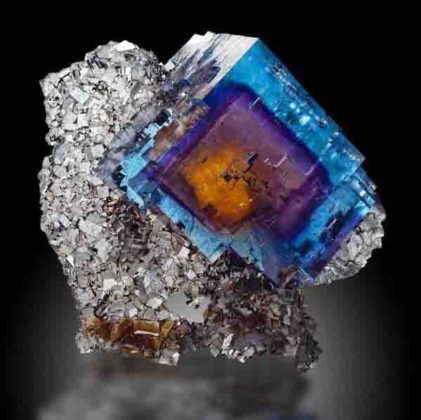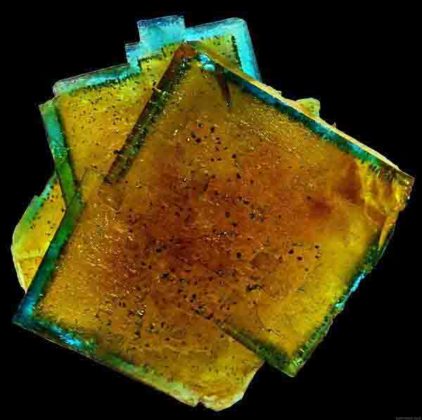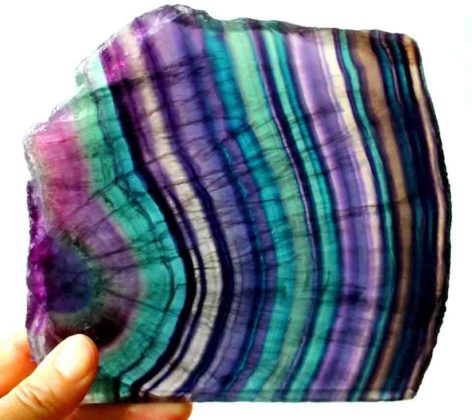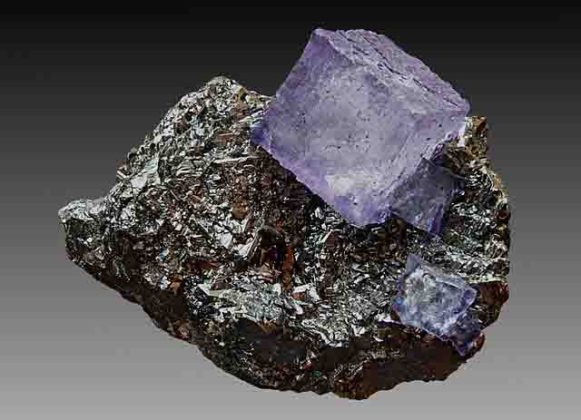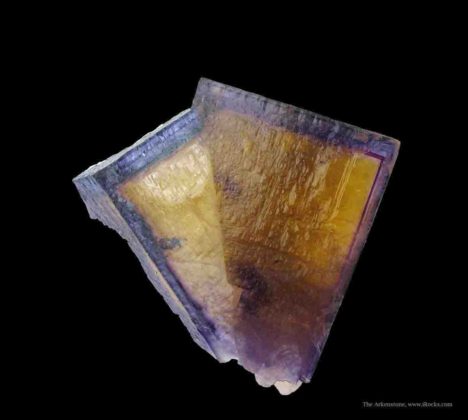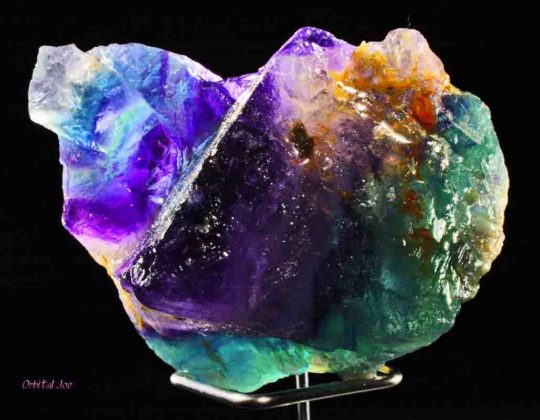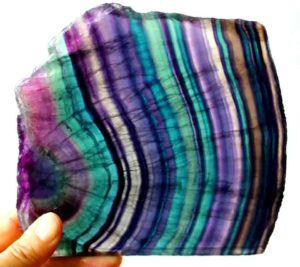
Fluorite (also called fluorspar) is the mineral form of calcium fluoride, CaF2. It belongs to the halide minerals. It crystallizes in isometric cubic habit, although octahedral and more complex isometric forms are not uncommon.
Mohs scale of mineral hardness, based on scratch Hardness comparison, defines value 4 as Fluorite.
Fluorite is a colorful mineral, both in visible and ultraviolet light, and the stone has ornamental and lapidary uses. Industrially, fluorite is used as a flux for smelting, and in the production of certain glasses and enamels. The purest grades of fluorite are a source of fluoride for hydrofluoric acid manufacture, which is the intermediate source of most fluorine-containing fine chemicals. Optically clear transparent fluorite lenses have low dispersion, so lenses made from it exhibit less chromatic aberration, making them valuable in microscopes and telescopes. Fluorite optics are also usable in the far-ultraviolet and mid-infrared ranges, where conventional glasses are too absorbent for use.
The many colors of fluorite are truly wonderful. The rich purple color is by far fluorite’s most famous and popular color. It easily competes with the beautiful purple of amethyst. Often specimens of fluorite and amethyst with similar shades of purple are used in mineral identification classes to illustrate the folly of using color as the sole means to identify minerals.
The blue, green and yellow varieties of fluorite are also deeply colored, popular and attractive. The colorless variety is not as well received as the colored varieties, but their rarity still makes them sought after by collectors. A brown variety found in Ohio and elsewhere has a distinctive iridescence that improves an otherwise poor color for fluorite. The rarer colors of pink, reddish orange (rose) and even black are usually very attractive and in demand.
Most specimens of fluorite have a single color, but a significant percentage of fluorites have multiple colors and the colors are arranged in bands or zones that correspond to the shapes of fluorite’s crystals. In other words, the typical habit of fluorite is a cube and the color zones are often in cubic arrangement. The effect is similar to phantomed crystals that appear to have crystals within crystals that are of differing colors. A fluorite crystal could have a clear outer zone allowing a cube of purple fluorite to be seen inside. Sometimes the less common habits such as a colored octahedron are seen inside of a colorless cube. One crystal of fluorite could potentially have four or five different color zones or bands.
To top it all off, fluorite is frequently fluorescent and, like its normal light colors, its fluorescent colors are extremely variable. Typically it fluoresces blue but other fluorescent colors include yellow, green, red, white and purple. Some specimens have the added effect of simultaniously having a different color under longwave UV light from its color under shortwave UV light. And some will even demonstrate phosphorescence in a third color! That’s four possible color luminescence in one specimen! If you count the normal light color too. The blue fluorescence has been attributed to the presence of europium ions (Eu +2). Yttrium is the activator for the yellow fluorescence. Green and red fluorescent activation is not exactly pinned down as of yet, but may be due to the elements already mentioned as well as other rare earth metals; also manganese, uranium or a combination of these. Even unbonded fluorine trapped in the structure has been suggested. The word fluorescent was derived from fluorite since specimens of fluorite were some of the first fluorescent specimens ever studied. The naming followed the naming precedence set by opalescence from opal; ergo fluorescence from fluorite.
Another unique luminescent property of fluorite is its thermoluminescence. Thermoluminescence is the ability to glow when heated. Not all fluorites do this, in fact it is quite a rare phenomenon. A variety of fluorite known as “chlorophane” can demonstrate this property very well and will even thermoluminesce while the specimen is held in a person’s hand activated by the person’s own body heat (of course in a dark room, as it is not bright enough to be seen in daylight). The thermoluminescence is green to blue-green and can be produced on the coils of a heater or electric stove top. Once seen, the glow will fade away and can no longer by seen in the same specimen again. It is a one shot deal. Chlorophane (which means to show green) is found in very limited quantities at Amelia Court House, Virginia; Franklin, New Jersey and the Bluebird Mine, Arizona, USA; Gilgit, Pakistan; Mont Saint-Hilaire, Quebec, Canada and at Nerchinsk in the Ural Mountains, Russia.
Fluorite has other qualities besides its great color assortments that make it a popular mineral. It has several different crystal habits that always produce well formed, good, clean crystals. The cube is by far the most recognized habit of fluorite followed by the octahedron which is believed to form at higher temperatures than the cube. Although the cleavage of fluorite can produce an octahedral shape and these cleaved octahedrons are popular in rock shops the world over, the natural (e.g. uncleaved) octahedrons are harder to find.
A rarer habit variety is the twelve sided dodecahedron however it is never seen by itself and usually modifies the cubic crystals by replacing the edges of the cube with one flat face of a dodecahedron. The tetrahexahedron is a twenty four sided habit that is also seen modifying the cubic habit. But instead of one face replacing each cubic edge, two faces modify the cube’s edges. Occasionally combinations of a cube, dodecahedron and tetrahexahedron are seen producing an overall cubic crystal with no less that three minor parallel faces replacing each cubic edge. A fifth form is the hexoctahedron which modifies the cube by placing six very minor faces at each corner of the cube. Twinning is also common in fluorite and symmetrical penetration twins, especially from Cumberland England are much sought after by collectors.
Fluorite, as mention above, has octahedral cleavage. This means that it has four identical directions of cleavage and when cleaved in the right ways can produce a perfect octahedral shape. Many thousands of octahedrons are produced from massive or large undesirable crystals of fluorite (hopefully!) and are sold in rock shops and museum gift shops at a small cost. Fluorite mine workers are reported to sit down at lunch breaks and cleave the octahedrons for the extra cash. The octahedrons are very popular due to their attractive colors, clarity, “diamond-shaped” and low costs, but to a serious collector they are nothing more than “cleavage fragments”.
Fluorite not only is attractive in its own right but is often associated with other attractive minerals. Fluorite crystals will frequently accompany specimens of silver gray galena, brassy yellow pyrite, chalcopyrite or marcasite, golden barite, black sparkling sphalerite, intricately crystallized calcite and crystal clear quartz, even amethyst.
The origin of the word fluorite comes from the use of fluorite as a flux in steel and aluminum processing. It was originally referred to as fluorospar by miners and is still called that today. Fluorite is also used as a source of fluorine for hydrofluoric acid and fluorinated water. The element fluorine also gets its name from fluorite, fluorines only common mineral. Other uses of fluorite include an uncommon use as a gemstone (low hardness and good cleavage reduce its desirability as a gemstone), ornamental carvings (sometimes misleadingly called Green Quartz) and special optical uses.
Fluorite is the most popular mineral for mineral collectors in the world, second only to quartz. Every mineral collection owned by even the newest and youngest of mineral collectors must have a specimen of fluorite. Fluorite is by far one of the most beautiful and interesting minerals available on the mineral markets.
Photos
Reference:
Fluorite – Mineral Gallery
Fluorite – Wikipedia


